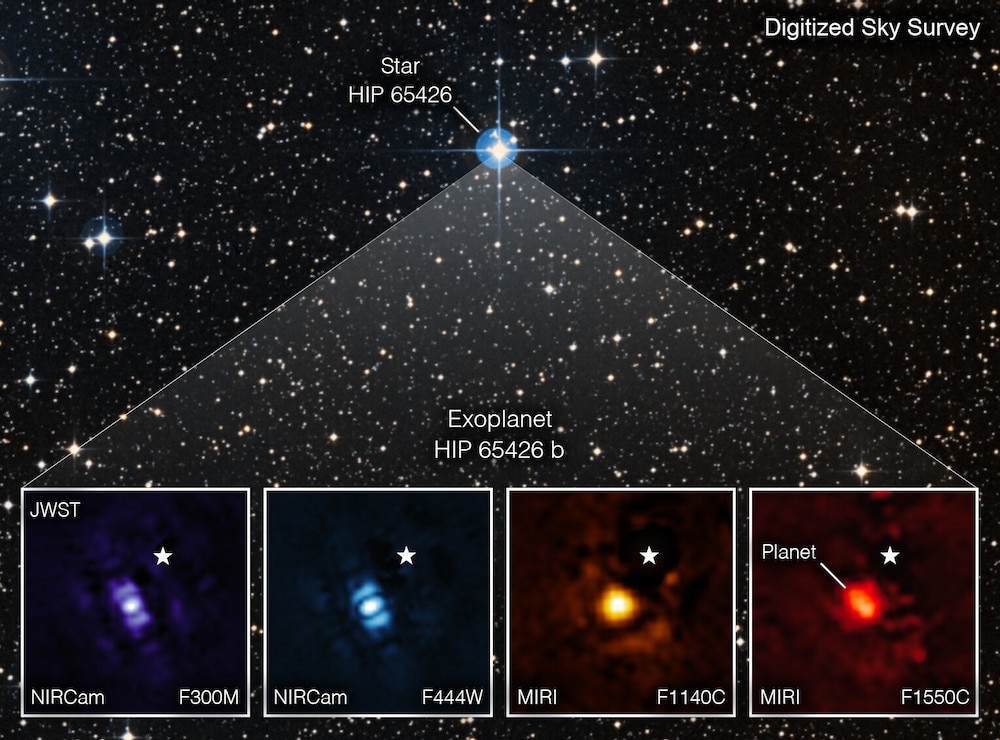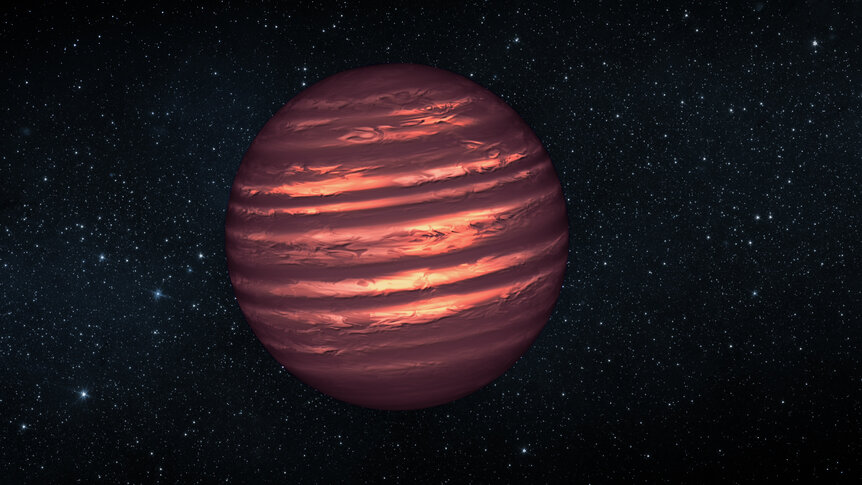Create a free profile to get unlimited access to exclusive videos, sweepstakes, and more!
JWST takes its first direct image of an exoplanet
HIP 65426b is a hot super-Jupiter orbiting a very young nearby star.

JWST has observed its first exoplanet, getting direct images of a super-Jupiter across multiple wavelengths, and showing the promise the huge space observatory has for exoplanet science.
The planet’s host star is called HIP 65426, a bright star — nearly naked-eye visible — in the constellation of Centaurus. It’s about 350 light-years away from us, and what’s called an A-type star: more massive, hotter, and more luminous than the Sun. It’s very young, something like 14 million years old.
The planet, called HIP 65426b, was discovered in 2017 using images from the mighty Very Large Telescope (or VLT) equipped with the SPHERE camera. Initial observation indicated it’s pretty far out from its star, about 16.5 billion kilometers. That’s 110 times the Earth-Sun distance, or nearly four times farther out than Neptune is from the Sun.
Because the planet is so young it is still extremely hot from the process of its formation; a planet grows by accumulating matter, which is essentially like getting hit by huge asteroids every day for millions of years. That does tend to heat things up, and that’s crucial for the JWST observations.
We see the planets in our own solar system because they reflect the light of the Sun, but for exoplanets that’s a difficult observation. Stars are extremely bright and planets very dim, so the planet might be a billion times fainter than the nearby star, and so close in the sky it’s nearly impossible to see. But if a planet is massive and young, it glows brightly enough in infrared to see. This is how HIP 65426b was discovered, and why JWST was able to see it [link to paper; note it has not yet been peer-reviewed but much of their analysis matches what was seen in the discovery paper published in 2017].
JWST observed HIP 65426b with its NIRCAM and MIRI instruments, seeing it in all seven filters used in wavelengths ranging from 2.5 microns — a wavelength roughly three times longer than the reddest light the human eye can perceive — out to 15 microns.
The observations were tricky due to the star being so bright. To reduce its glare the astronomers employed a technique called angular differential imaging, taking an image of the star and planet and then physically rotating JWST and taking another image. One image is then subtracted form the other to reduce the star’s glare without also zeroing out the light from the planet. In addition they also observed a nearby star of similar color to HIP 65426 and subtracted it from the image, thereby reducing the host star’s glare even further. They also used a coronagraph in both instruments, literally a piece of metal that blocks the center of the star, reducing its brightness by a huge factor while letting light from the planet past — like using your hand to block the Sun to see a cloud near it. All of these methods together made it possible to spot HIP 65426b in the images.
The JWST observations constrain the orbit of the planet to being an ellipse with a semi-major axis — half the distance across the long axis — of 13 billion kilometers, and we see it just 10° from being edge-on. Given the current distance of more than 16 billion kilometers this means the orbital is fairly elliptical.
The JWST observations together with those from the planet’s discovery with VLT, combined with physical models of how planets emit light for a given age and mass, yield a mass for HIP 65426b of 7.1±1.1 times that of Jupiter. So it’s hefty, but still well below the 13-Jupiter-mass limit for brown dwarfs. In other words, it’s definitely a planet.
They also find a size of 1.5 times Jupiter’s diameter. Planets more massive than Jupiter tend to actually be smaller because of weird quantum mechanical physics that goes on inside them, but HIP 65426b is bigger because it’s hot. When you inflate a gas it expands, and the same is true for gas giant planets. The JWST observations indicate a temperature of nearly 1,000°C (1,800°F). So, yeah. Hot.
Spectra taken of the planet from 2020 using VLT indicate the presence of water molecules in the atmosphere of the planet, and may have others like carbon monoxide and methane. Spectra using JWST would be incredibly difficult due to the bright host star so close by, however. Still, these new observations show that the space observatory can indeed image planets near stars. The key is contrast, the ratio of the planet’s brightness to the star’s, and these observations indicate JWST is performing ten times better than expected when it comes to contrast achieved. That’s incredible.
Many more exoplanets are already in the pipeline for observations, and in fact several already have been targeted; I’m particularly excited about observations of the Earth-sized planets orbiting the nearby red dwarf star TRAPPIST-1; those should yield some information on the atmospheres of the planets!
HIP 65426b is the first exoplanet imaged by JWST. It won’t be the last, and we’re only just now seeing the beginning of what this observatory can do.




























